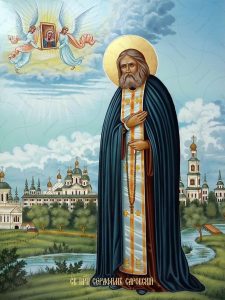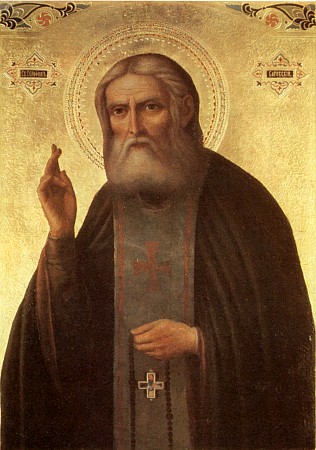Church of St. Seraphim of Sarov in Kuntsevo, Patriarchal Compound

St. Seraphim of Sarov is one of the greatest ascetics of the Russian Church, renowned for his deep faith, feats of piety, and special closeness to God. He was born on July 19, 1754 in Kursk in the family of Moshnin: a merchant Isidore and his wife Agafiya. Since childhood, Prokhor showed a special penchant for spiritual life. He was happy to attend church services, loved to read the Holy Scriptures and the lives of saints, sharing this knowledge with his peers. However, he especially liked to retire to prayer and read the Gospel. As a child, a miraculous event happened to him: one day he fell from the high bell tower of a cathedral under construction, but remained completely unharmed, which his mother perceived as God`s obvious protection. Another miraculous sign in the life of the future saint was the healing of a serious illness. As a child, he became seriously ill and his life was in danger. In a dream, the Most Holy Theotokos appeared to him, promising healing. Soon, a procession with a miraculous icon of the Sign of the Mother of God passed through the courtyard of their house. The mother carried her son out in her arms so that he could venerate the icon, and soon after that he began to recover rapidly. From an early age, Prokhor made an unyielding decision to devote his life to serving God. His pious mother not only did not hinder this choice, but also blessed her son on the monastic path, giving him a crucifix, which he wore on his chest all his life. After leaving his parents` house, he set off on foot to Kiev to venerate the shrines of the Kiev Pechersk Lavra. There he met with the elder schema-monk Dosifey, who blessed him to go to the Sarov desert. November 20, 1778 Prokhor arrived at the Sarov monastery, where Elder Pakhomiy was then the abbot. The young man was received with love and diligently performed various monastic obedience: he worked as a cell attendant, worked in a bakery, a milliner`s shop, and performed the duties of a sexton. Everything he did was filled with sincere jealousy and deep humility. He considered any work to be a service to God and constantly instructed others to pray, abstain from idle talk, hard work and patience. Soon, following the example of other monks who went to pray in the forest, he asked for a blessing for a solitary prayer. However, he soon became seriously ill – his body was swollen, and he suffered greatly. The illness lasted about three years, but not once did he show any grumbling or despondency. When his life seemed to be running out, the Most Holy Theotokos appeared to him again, accompanied by the Apostles Peter and John the Theologian. Pointing to the sick man, she said, “This is from our family,” after which she touched him with a rod. At the same moment, the tumor disappeared, and the monk was completely healed. In memory of this miracle, a church was built on the site of the apparition of the Virgin, and the saint made the altar for her with his own hands. After eight years of novitiate, he took monastic vows with the name Seraphim, which means “fiery.” Soon he was ordained a hierodeacon, and then a hieromonk. His ministry in the temple was accompanied by extraordinary spiritual grace. One day, during the Divine Liturgy on Holy Thursday, he saw the Lord Jesus Christ walking through the air surrounded by angels. After this vision, he intensified his exploits, spending his nights in prayer in a forest cell. In 1793, the monk went into seclusion, settling in a remote forest a few kilometers from the monastery. Here he devoted himself to strict fasting and unceasing prayer. He kept himself in severe austerities, eating only herbs and roots, and in the first days of Great Lent he completely abstained from food. The enemies of the human race tried to break his spirit: the devil terrified him with visions, led him into temptation, but the saint was strengthened by prayer. For 1,000 days and nights, he performed the feat of standing on a rock, calling out: “God, be merciful to me, a sinner.” Soon robbers attacked him, severely beat him, broke his head, and broke his ribs, but the saint did not resist, remembering the words of Christ: “Those who take the sword with the sword will perish” (Matthew 26:52). The robbers, having found nothing in his cell, left in fear. He was brought to the monastery half-dead, but he was miraculously healed after the appearance of the Most Holy Theotokos to him. After that, he accepted the feat of silence, and then completely went into seclusion, giving himself up to solitary prayer. In 1825, the Mother of God appeared to him and ordered him to go out to the people. From that time on, the monk began to receive all those who sought spiritual guidance. He possessed the gift of foresight and healing, comforted many and helped them find a way to salvation. He especially cared about the Diveevo convent, considering it his spiritual child. He mentored the sisters, nursed them, and helped them with everything. On January 2, 1833, St. Seraphim surrendered his soul to God during prayer, kneeling before the icon of the Theotokos “Tenderness”, which was his inseparable companion. He left the world an example of the deepest faith, love and humility, and his teachings and prophecies continue to inspire believers. In 1903 he was canonized by the Russian Orthodox Church and is still one of the most revered saints. A temple has been erected in Moscow in memory of him.
Address: Moscow, Bagritskogo, 10, building 3, building 1

